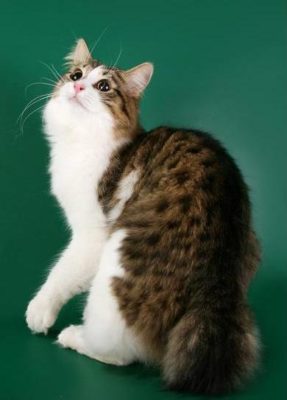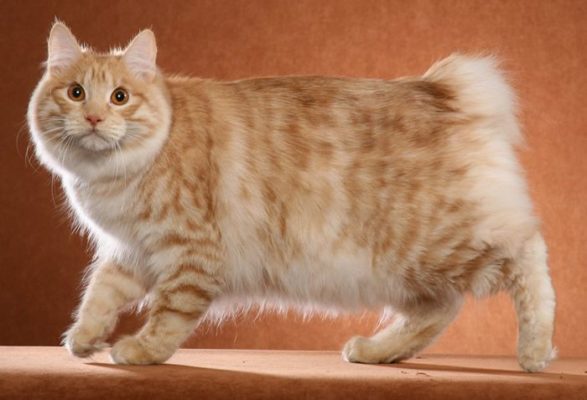Karelian Bobtail Longhair

The Karelian Bobtail Longhair combines inquisitiveness, independence, and affection in its character. It is friendly to strangers, moderately active, and adapts well to any living conditions. Karelian Bobtail is not too generous with its meow. He prefers to communicate using gestures rather than voice. The sounds produced by the Karelian Bobtail Longhair are more reminiscent of a purr.
Table of Contents
Breed Information
| Origin | Russia |
| Size | Males 26-28 cm Females 25-27 cm |
| Weight | Males 4.5-6 kg Females 2.5-4 kg |
| Fur Type | Semi-long-haired |
| Color | Any color variations are possible, except for chocolate and brown-pale as well as colorpoint |
| Lifestyle | Outdoors, indoors |
| Lifespan | 15-18 years |
| FIFe Classification | – |
| WCF Classification | Group 2: “Semi-long-haired” Breed designation – KAL |
| TICA Classification | – |
| Group | Long-haired cats |
| Price | $500-1000 |
Breed Photos
Origin History
The Karelian Bobtail breed began its formation on modern Karelia near the islands of Lake Ladoga. It got its name just because of the place where the first representatives were found. It is considered a Russian aboriginal breed of cat. Because of the similarity of external features and names, some people mistakenly speak about the Karelian and Kurilian Bobtails’ kinship.
Breed researchers have confirmed that Karelian Bobtails are not genetically related to Smokies in the course of their work. The main difference between Karelian Bobtails and Smokies is the recessive gene of cattails. That means both parents must possess this gene to have offspring with the same traits. At the same time, the gene is dominant in smokers.
The first standard of the breed was created by the members of KLC “Kotofei” in 1987. Saint-Petersburg breeders paid attention to the short-tailedness of cats. They agreed that the ancestors of the Karelian bobtail were Norwegian forest cats. Karelian bobtail was first presented at the intercontinental exhibition in 1993.
WCF recognized the breed standard in 1994. Since 2012, the Karelian cattery “North-western Sky” has been breeding the breed. According to legend, bobtail cats bring happiness to the house. Therefore, the Karelian Bobtail Longhair remains quite a popular cat breed even outside its homeland.
Appearance
The Karelian Bobtail’s angular appearance makes it somewhat clumsy. However, it seems so only at first sight. The Karelian Bobtail Longhair is a medium-sized cat with a short tail characteristic of the breed. It is because of this feature that the Karelian Bobtail looks a little funny. The head is shaped like an isosceles triangle.
The muzzle is quite narrow. The ears are large, set high. The eyes are slightly slanting, oval. The color of the eyes should be monochromatic and in harmony with the color of the coat. The most common eye colors are yellow and green.
Limbs with developed musculature, but not coarse. The tail is necessarily short (4-13 cm) and slightly curved. On the tail, hair is longer, arranged in a pompon or tassel form. According to the standard, Karelian Bobtail fur is half-long. Very dense coat with a soft undercoat. Also, the presence of ornamental hair, that is, “collar”, “pants” and tassels on the ears, is a must. Various color variations are acceptable except colorpoint, Abyssinian, Burmese, and chocolate purple.
Character
The Karelian Bobtail Longhair combines inquisitiveness, independence, and affection in its character. It is friendly to strangers, moderately active, and adapts well to any living conditions. Karelian Bobtail is not too generous with its meow. He prefers to communicate using gestures rather than voice. The sounds produced by the Karelian Bobtail Longhair are more reminiscent of a purr.
He has a patient attitude toward children and is not prone to aggression. Also, he is not too obtrusive but rather highly values his own space and peace. Regards pets calmly. Karelian Bobtail Longhair will find a common language with cats, dogs and can distinguish pets from prey.
Care
When keeping a Karelian Bobtail, its long hair will require special attention. It needs daily combing. It is necessary to avoid permanent hair tangling and unnecessary loss. It is recommended to bathe Karelian Bobtails once in several months. Be sure to use gentle, mild shampoos for long-haired cats. It will help you to keep a shiny coat of your pet.
The rest of the care comes down to standard hygienic recommendations. Brush his teeth and ears regularly, and trim his nails. It is advisable to do it every week. In this way, you will ensure that your pet feels comfortable and looks well-groomed.
Education
Owners of the Karelian Bobtail Longhair note its good tendency to learn. It can be easily accustomed to the house rules in the house, coping with needs, or to the scratching post. They have a high level of intelligence and always follow their master’s requests. Karelian Bobtail is easy to contact and non-confrontational.
Common Diseases
Worry about the health of the Karelian Bobtail Longhair; you do not have to. Nature has taken care of their immunity. They do not have severe hereditary pathologies and are prone to most diseases. However, you should not forget about the annual visit to the veterinarian. Examinations and seasonal vaccinations are a must, regardless of the health of the pet.
Nutrition
The diet of the Karelian Bobtail Longhair must be selected based on the lifestyle of the animal. It is very important that the menu is balanced and feeding is regular. Karelian Bobtails can be fed ready-made premium food or natural products.
 Turkish Angora
Turkish Angora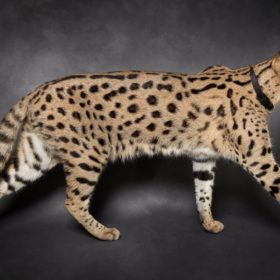 Savannah
Savannah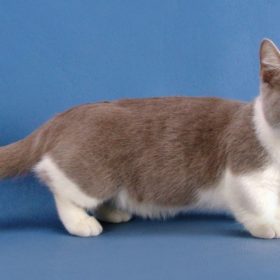 Munchkin Shorthair
Munchkin Shorthair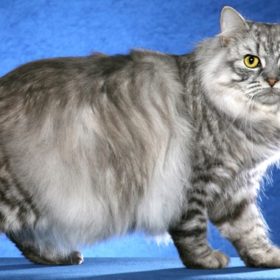 Cymric
Cymric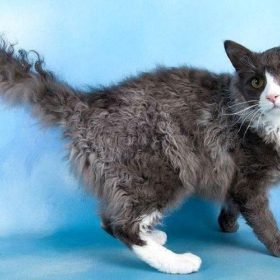 LaPerm Longhair
LaPerm Longhair Turkish Van
Turkish Van
